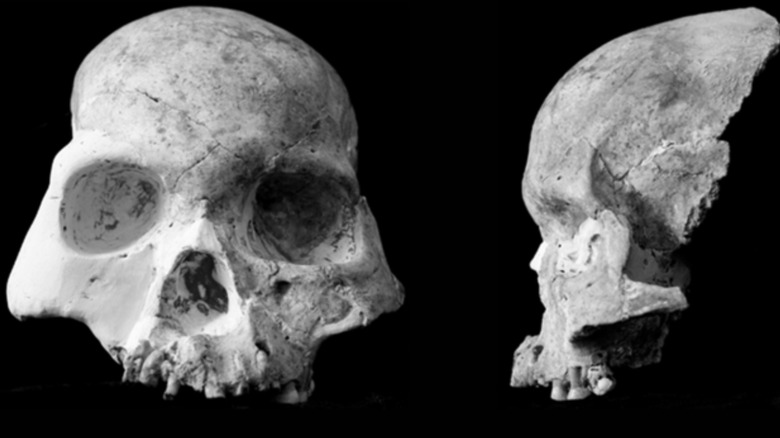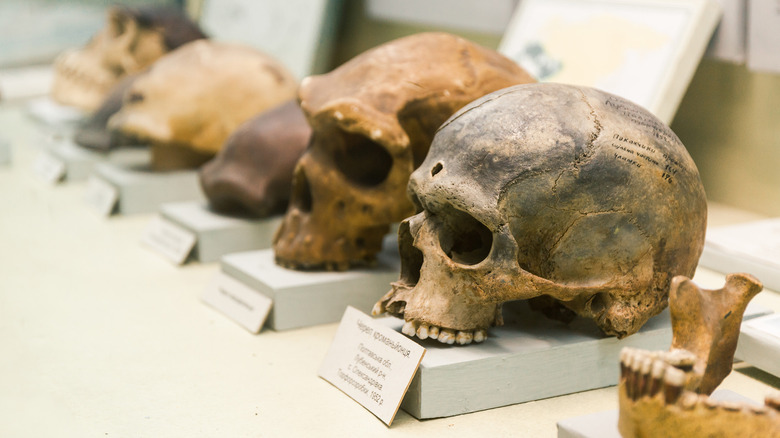A New Study Has Researchers Re-Examining The Ancestry Of Native Americans
In July 2022, scientists released data that may reveal previously unknown details about human migration from China to North America, and the East Asian ancestry of some Native Americans. A paper published in Current Biology demonstrates the richness and complexity of data available with genome sequencing — in particular, as it pertains to a 14,000-year-old skull.
Three decades ago in southwestern China, deep within the Yunnan Province that was home to the dark, fossil-rich Red Deer Cave (also known as Maludong), Chinese researchers stumbled upon approximately 30 pieces of bone. Whose bones were these? Did they belong to a human? Could they tell us anything new about the story of humanity's history? Scientists initially weren't sure, but ancient DNA taken from the 14,000-year-old skull answers the last question with a definitive yes.
"Ancient DNA technique is a really powerful tool," said researcher Bing Su in a Eureka Alert news release about the discovery.
The 14,000-year-old skull belonged to an East Asian ancestor of many Native Americans
Carbon dating indicates the bones found in Red Deer Cave were the remains of a human that lived about 14,000 years ago, during the Late Pleistocene. The Pleistocene is a geological time period that began around 2 million years ago and lasted until 11,700 years ago (via Britannica). It's mostly known as the time period when the Great Ice Age happened. And according to the paper published in Current Biology, it's also the time period when some humans in southern China migrated to North America — a group of humans that would become the ancestors of some Native Americans.
Upon first discovery of the remains (according to Eureka Alert), the 14,000-year-old skull didn't look like it belonged to a modern human: Its shape (resembling a Neanderthal's) and the size of its brain (slightly smaller than a modern human's) led some archaeologists to believe the remains found in Red Deer Cave belonged to a hybrid hominid species.
When Xueping Ji, an archaeologist at Yunnan Institute of Cultural Relics and Archaeology, and Bing Su, a researcher at Kunming Institute of Zoology at the Chinese Academy of Sciences, and their teams extracted DNA from the 14,000-year-old skull in 2018, the human-archaic-hybrid hypothesis was disproven. According to Eureka Alert, genome testing yielded startling results: The skull did belong to a modern human — in particular, it belonged to a woman from an extinct maternal branch of homo sapiens.
Researchers reconstruct migratory patterns from Asia to North America
Three years later, researchers have at last finished sequencing the Pleistocene genome (dubbed "MZR" for the purposes of the study). The data was published in Current Biology on July 14, 2022. Researchers believe her genome suggests that her descendants traversed from Asia to the North American continent. By comparing genomic data across different groups (including the 1000 Genome Project, per Current Biology), the authors of the study were able to deduce some information about MZR's heritage and her ancestors' migratory patterns. The authors suggest that MZR's relatives who migrated did so by traveling north along the eastern coast of modern China, passing through Japan, and then traversing Siberia. Finally, according to researchers, these humans crossed the Bering Strait to leave Asia, arriving on the western coast of the North American continent (per Eureka Alert).
Researchers say their data reveals new details about some Native Americans' ancestral links to Asia. Author Bing Su said the sequenced genome is a rich resource for discovering more about humanity's history: "It is an important piece of evidence for understanding early human migration," he said in Archaeology.


